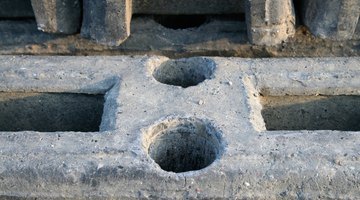How to Build a Shower Seat Out of Cinder Blocks
Constructing a shower on site allows a homeowner to include any of a number of custom shower features built to the desired specifications. One shower article often included in shower fabrication to increase comfort and convenience while also boosting accessibility is a seat or bench.

Things You Will Need
- Cinder blocks
- Safety glasses
- Gloves
- Hammer
- Mortar
- Trowel
- Damp sponge
- Level
- Straightedge
- Finishing and tools (thinset mortar, notched trowel, tiles, tile cutters, spacers)
A seat can be built up using cinder blocks and mortar. To construct a durable and attractive shower seat, the seat should be planned well and carefully fabricated and finished.
-
Complete the shower pan and walls up to the point that a seat can be installed. The shower pan must have a pan liner already installed so that any water that penetrates the seat will drain to the drain opening. If possible, build the seat on top of the mortar bed before thinset mortar and tiles are installed and after the wall has been covered with cement backerboard or a mortar bed.
-
Plan the general shape of the seat and break up blocks as needed to accommodate the design. The seat form can range from a seat with a single face tucked into a corner and triangular top to a three-sided box along the wall or a half-circle. Use a hammer to obtain sections of blocks to fit the plan and do a dry run, stacking the blocks without mortar to form the face of the seat. Save any fragments of blocks. These pieces will be used later to fill in any space between the course of block that makes up the face of the seat and the wall.
-
Prepare the mortar for the seat. The same mortar that was used for the shower pan or for the walls can be used.
-
Spread a layer of mortar about 1 inch thick on the area of the shower pan where the seat will be built.
-
Dampen the cement backerboard or mortar walls where the new mortar will be in contact with the walls using a damp sponge. This will keep the wall from quickly absorbing the moisture from the mortar and hindering the curing process.
-
Set the first block or brick in the mortar on the shower floor, wiggling it gently as it is placed to force out any air bubbles. Hold the level against the block to check for evenness and adjust the block as needed.
-
Complete the remainder of the first course using whole blocks or segments, depending on the design. Butter the end of each block before placing it against the adjacent block. Use a level to ensure that the faces and tops of the blocks are even. Achieve as even a facade as possible, but do not worry if the faces of the blocks in the first and subsequent levels are not completely plumb; this can be corrected later with a layer of mortar and straightedge.
-
Build a second and any subsequent courses as desired atop the first level of mortared blocks. Spread a layer of mortar on top of the first course of blocks and set the next level of blocks or block sections, with mortared ends, in the mortar. Again, check for level and evenness.
-
Fill in any space between the mortared blocks and the wall if the design of the seat left a gap between the blocks that form the face or sides of the seat and the wall. Use mortar and blocks or segments of blocks to fill the space, building it up to the top of the face blocks.
-
Mortar the top of the seat once the void has been filled with rubble and mortar. The top of the seat should have a slight slope to facilitate runoff toward the drain. Spread mortar over the top of the seat, building it up about 1/2 inch higher in the rear. Run a straightedge over the top of the seat to identify any low or high spots and adjust the mortar as needed. Use a level to make sure that a slight slope is present.
-
Mortar the front of the seat as needed to create a smooth, even finish. Pack mortar into any voids or low spots and use a straightedge and level to locate any low spots or scrape off excess mortar. Let the mortar cure before continuing.
-
Surface the seat, floor and walls as desired. To tile the shower, work in small, manageable sections. Spread thinset mortar over a small area using a notched trowel, press tiles into the mortar, use tile spacers between tiles to maintain uniform gaps and use a level frequently to check for evenness. Cut tiles as needed to fit the walls or design using a tile cutter or other tool. Once all surfaces have been tiled, apply grout to fill in spaces between tiles and seal all corners with a bead of silicone caulk.
References
- Tile Your World -- John Bridge's New Tile Setting Book: John P. Bridge
- Residential Construction Academy -- Plumbing: Michael Joyce
- Popular Science; Tiling Tricks -- Customize Your Bath; Al Lees
Writer Bio
Angela Ryczkowski is a professional writer who has served as a greenhouse manager and certified wildland firefighter. She holds a Bachelor of Arts in urban and regional studies.
Photo Credits
- Jupiterimages/Photos.com/Getty Images
- Jupiterimages/Photos.com/Getty Images
More Articles



